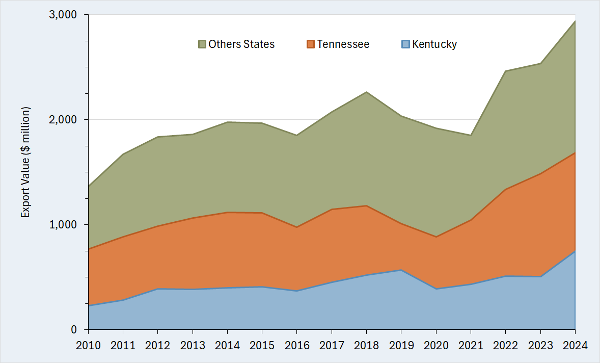Distilled spirits fall into six main categories: whiskey (which includes bourbon), vodka, rum, gin, tequila, and brandy. Each is defined by its key ingredient, for example, rum is produced from sugarcane, brandy from grapes, and whiskey from corn and other grains. Production methods, geography, and legal requirements also help in defining these categories. Tennessee Whiskey and Kentucky Bourbon are iconic American spirits, elevating these states to leading exporter status.
American distilled spirits enjoy global popularity and are among the nation’s top agricultural exports. Despite disruptions from the 2018 trade war and the COVID-19 pandemic, exports have shown a steady upward trend reaching almost $3.0 billion in 2024 (Figure 1). Tennessee and Kentucky lead the nation in distilled spirits exports, consistently ranking first and second among exporting states, respectively. While distilled spirits make up approximately 2% of total agricultural exports nationwide, they dominate sales in both states, accounting for 36% of Tennessee’s and 48% of Kentucky’s agricultural exports in 2024. That year, Tennessee exported over $900 million worth of distilled spirits, while Kentucky shipped around $750 million, together comprising more than half of the country’s total distilled spirits export revenue. For comparison, Texas, the third-largest exporting state, had around $350 million in distilled spirits exports in 2024.
Both Canada and the EU have been embroiled in the recent trade actions by the Trump Administration. In response, both countries have either implemented or proposed retaliatory tariffs on U.S. good including distilled spirits. What is at stake if Canada and the EU impose retaliatory tariffs on American distilled spirits?
Because retaliatory tariffs could seriously impact distilled spirits, disrupting export sales, economic activity, and job stability, it is essential to evaluate what is at risk. Our research shows that although export sales to the EU and Canada for the two states combined average around $760 million annually from 2022-2024, the totaled economic impact was over $1.2 billion and nearly 3,000 jobs. These findings highlight how distilled spirits exports create a ripple effect, influencing employment, tax revenue, and business activity across multiple sectors in Tennessee and Kentucky. If Canada or the EU were to impose tariffs on U.S. distilled spirits, it could lead to reduced exports, affecting the economic stability of distilleries and related industries. This could result in job losses, decreased income for workers, and lower tax revenues, ultimately harming the regional economy.
Figure 1. U.S. Distilled Spirits Exports (Tennessee, Kentucky, and Other States): 2010 – 2024

For More Information
Muhammad, A., R.J. Menard, S.A. Smith (2025) “Tennessee and Kentucky distilled spirits: What’s at stake from a new trade war?” Choices (In Press).


